Page 236 of 392
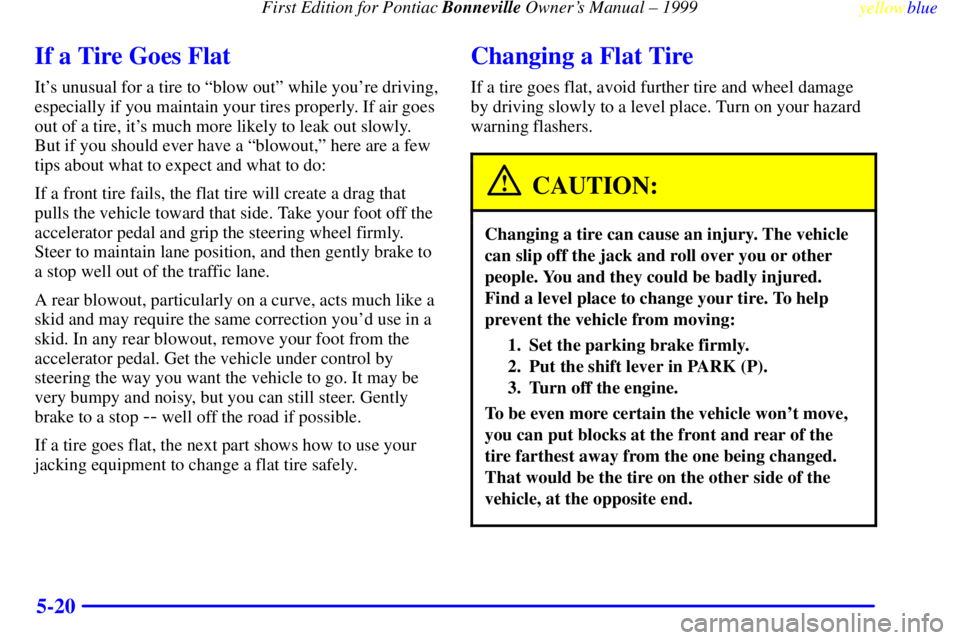
First Edition for Pontiac Bonneville Owner's Manual ± 1999
yellowblue
5-20
If a Tire Goes Flat
It's unusual for a tire to ªblow outº while you're driving,
especially if you maintain your tires properly. If air goes
out of a tire, it's much more likely to leak out slowly.
But if you should ever have a ªblowout,º here are a few
tips about what to expect and what to do:
If a front tire fails, the flat tire will create a drag that
pulls the vehicle toward that side. Take your foot off the
accelerator pedal and grip the steering wheel firmly.
Steer to maintain lane position, and then gently brake to
a stop well out of the traffic lane.
A rear blowout, particularly on a curve, acts much like a
skid and may require the same correction you'd use in a
skid. In any rear blowout, remove your foot from the
accelerator pedal. Get the vehicle under control by
steering the way you want the vehicle to go. It may be
very bumpy and noisy, but you can still steer. Gently
brake to a stop
-- well off the road if possible.
If a tire goes flat, the next part shows how to use your
jacking equipment to change a flat tire safely.
Changing a Flat Tire
If a tire goes flat, avoid further tire and wheel damage
by driving slowly to a level place. Turn on your hazard
warning flashers.
CAUTION:
Changing a tire can cause an injury. The vehicle
can slip off the jack and roll over you or other
people. You and they could be badly injured.
Find a level place to change your tire. To help
prevent the vehicle from moving:
1. Set the parking brake firmly.
2. Put the shift lever in PARK (P).
3. Turn off the engine.
To be even more certain the vehicle won't move,
you can put blocks at the front and rear of the
tire farthest away from the one being changed.
That would be the tire on the other side of the
vehicle, at the opposite end.
Page 260 of 392
yellowblue
6-10 Hood Release
To open the hood, first pull
the hood release handle
inside the vehicle. It is next
to the parking brake pedal
near the floor.
Then go to the front of the vehicle and push up on the
secondary hood release.
Lift the hood.
Before closing the hood, be sure all the filler caps are on
properly. Then just pull the hood down and close
it firmly.
Page 271 of 392
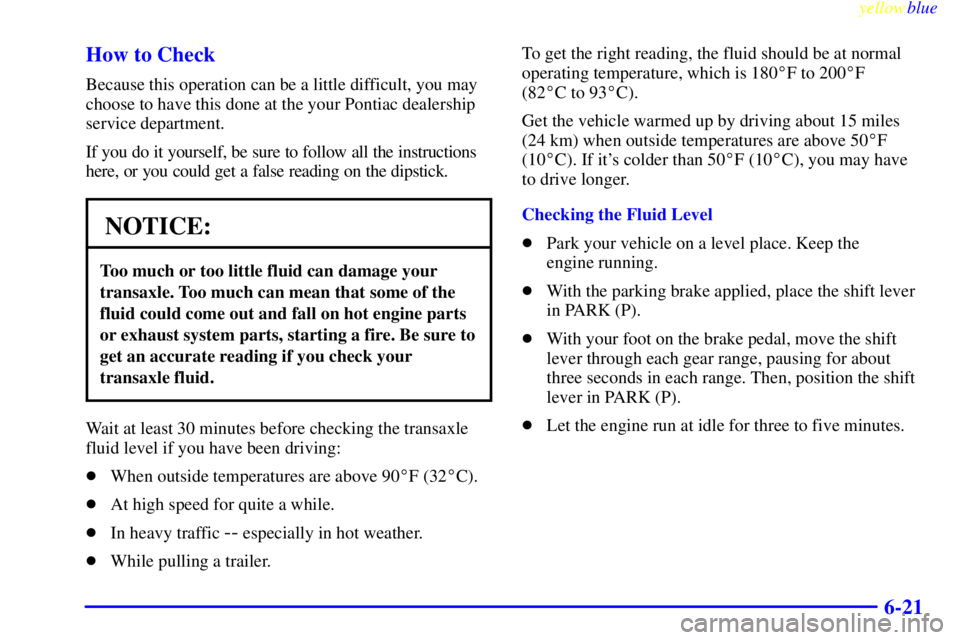
yellowblue
6-21 How to Check
Because this operation can be a little difficult, you may
choose to have this done at the your Pontiac dealership
service department.
If you do it yourself, be sure to follow all the instructions
here, or you could get a false reading on the dipstick.
NOTICE:
Too much or too little fluid can damage your
transaxle. Too much can mean that some of the
fluid could come out and fall on hot engine parts
or exhaust system parts, starting a fire. Be sure to
get an accurate reading if you check your
transaxle fluid.
Wait at least 30 minutes before checking the transaxle
fluid level if you have been driving:
�When outside temperatures are above 90�F (32�C).
�At high speed for quite a while.
�In heavy traffic
-- especially in hot weather.
�While pulling a trailer.To get the right reading, the fluid should be at normal
operating temperature, which is 180�F to 200�F
(82�C to 93�C).
Get the vehicle warmed up by driving about 15 miles
(24 km) when outside temperatures are above 50�F
(10�C). If it's colder than 50�F (10�C), you may have
to drive longer.
Checking the Fluid Level
�Park your vehicle on a level place. Keep the
engine running.
�With the parking brake applied, place the shift lever
in PARK (P).
�With your foot on the brake pedal, move the shift
lever through each gear range, pausing for about
three seconds in each range. Then, position the shift
lever in PARK (P).
�Let the engine run at idle for three to five minutes.
Page 315 of 392
yellowblue
6-65
Fuse Usage
3B Not Used
4B Not Used
5B
Anti
-Lock Brake System, Computer
Command Ride
6B Brake and Hazard Lamps
7B Not Used
8B Interior Lighting
9B Cigarette Lighter
1C Air Bag System
2C Spare
3C Not Used
4C Not Used
5C Cooling Fans, Transaxle
6C Parking Lamps/Interior Lamps
7C Not Used
8C Not Used
9C (Battery), Radio, Cluster
1D Ignition (Run/Crank),
Chime, ClusterFuse Usage
2D Spare
3D Heated Mirror
4D Not Used
5D Base A/C
6D Fog Lamps
7D Transaxle
8D Radio
9D Not Used
1E Not Used
2E
Air Bag System, PASS
-Key�
3E Not Used
4E Not Used
5E Rear Defog
6E Not Used
7E Miscellaneous Engine Controls
(Non
-OBD II)
8E Wipers, Washer
9E Not Used
Page 329 of 392

Short Trip/City Scheduled Maintenance
yellowblue
7-7
The services shown in this schedule up to 100,000 miles
(166 000 km) should be performed after 100,000 miles
(166 000 km) at the same intervals. The services shown
at 150,000 miles (240 000 km) should be performed at
the same interval after 150,000 miles (240 000 km).
See ªOwner Checks and Servicesº and ªPeriodic
Maintenance Inspectionsº following.
Footnotes
� The U.S. Environmental Protection Agency or the
California Air Resources Board has determined that the
failure to perform this maintenance item will not nullify
the emission warranty or limit recall liability prior to the
completion of the vehicle's useful life. We, however,
urge that all recommended maintenance services be
performed at the indicated intervals and the maintenance
be recorded.# Lubricate the suspension and steering linkage,
transaxle shift linkage, parking brake cable guides and
underbody contact points and linkage.
+ A good time to check your brakes is during tire
rotation. See ªBrake System Inspectionº under ªPeriodic
Maintenance Inspectionsº in Part C of this schedule.
++ If you drive in a highly corrosive environment, your
brake calipers may require additional inspection and
service, at every other tire rotation. See ªCaliper/Knuckle
Maintenance Inspectionº under ªPeriodic Maintenance
Inspectionsº in Part C of this schedule.
Page 344 of 392
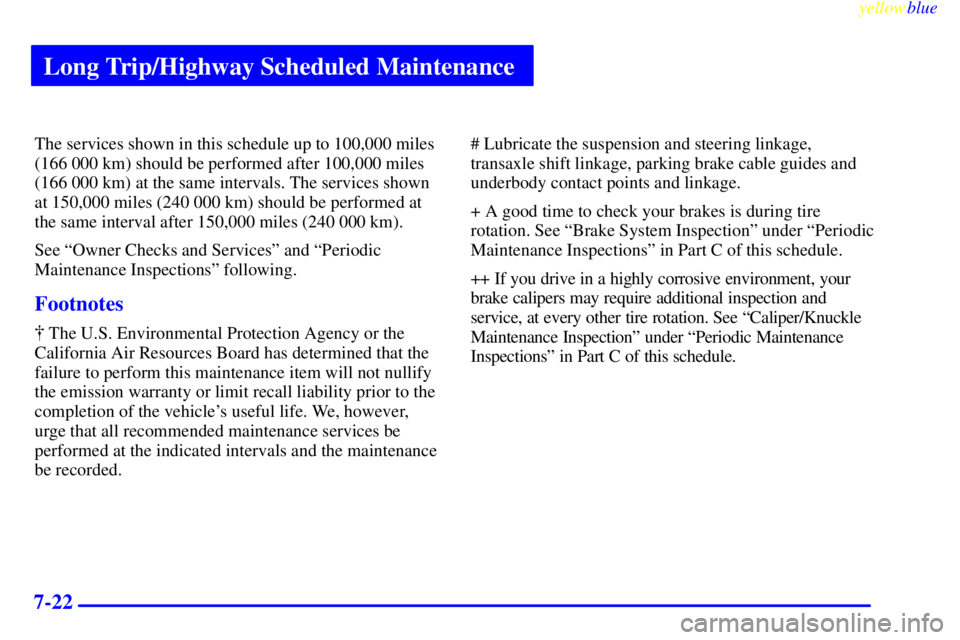
Long Trip/Highway Scheduled Maintenance
yellowblue
7-22
The services shown in this schedule up to 100,000 miles
(166 000 km) should be performed after 100,000 miles
(166 000 km) at the same intervals. The services shown
at 150,000 miles (240 000 km) should be performed at
the same interval after 150,000 miles (240 000 km).
See ªOwner Checks and Servicesº and ªPeriodic
Maintenance Inspectionsº following.
Footnotes
� The U.S. Environmental Protection Agency or the
California Air Resources Board has determined that the
failure to perform this maintenance item will not nullify
the emission warranty or limit recall liability prior to the
completion of the vehicle's useful life. We, however,
urge that all recommended maintenance services be
performed at the indicated intervals and the maintenance
be recorded.# Lubricate the suspension and steering linkage,
transaxle shift linkage, parking brake cable guides and
underbody contact points and linkage.
+ A good time to check your brakes is during tire
rotation. See ªBrake System Inspectionº under ªPeriodic
Maintenance Inspectionsº in Part C of this schedule.
++ If you drive in a highly corrosive environment, your
brake calipers may require additional inspection and
service, at every other tire rotation. See ªCaliper/Knuckle
Maintenance Inspectionº under ªPeriodic Maintenance
Inspectionsº in Part C of this schedule.
Page 356 of 392
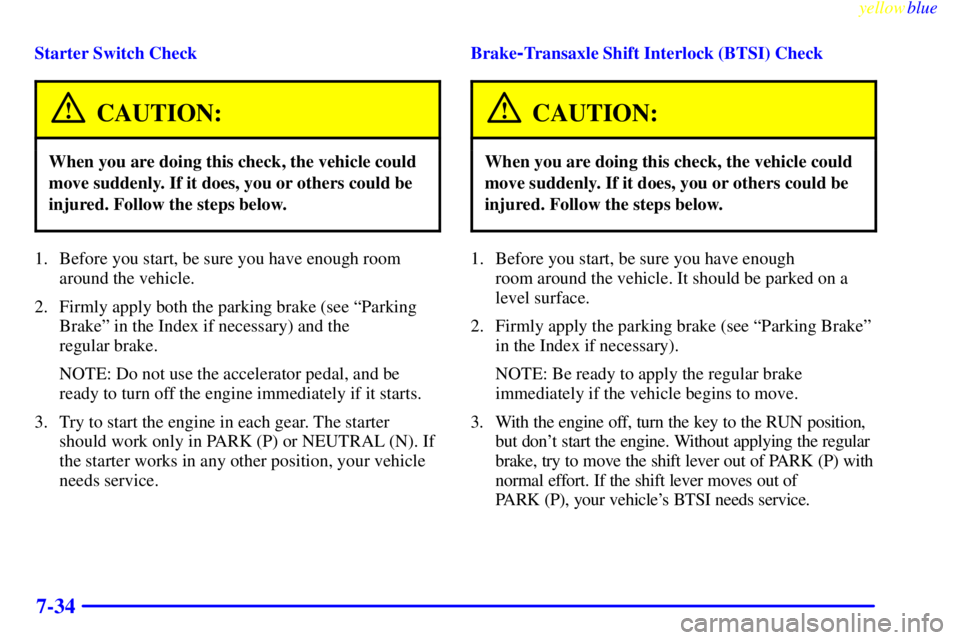
yellowblue
7-34
Starter Switch Check
CAUTION:
When you are doing this check, the vehicle could
move suddenly. If it does, you or others could be
injured. Follow the steps below.
1. Before you start, be sure you have enough room
around the vehicle.
2. Firmly apply both the parking brake (see ªParking
Brakeº in the Index if necessary) and the
regular brake.
NOTE: Do not use the accelerator pedal, and be
ready to turn off the engine immediately if it starts.
3. Try to start the engine in each gear. The starter
should work only in PARK (P) or NEUTRAL (N). If
the starter works in any other position, your vehicle
needs service.Brake
-Transaxle Shift Interlock (BTSI) Check
CAUTION:
When you are doing this check, the vehicle could
move suddenly. If it does, you or others could be
injured. Follow the steps below.
1. Before you start, be sure you have enough
room around the vehicle. It should be parked on a
level surface.
2. Firmly apply the parking brake (see ªParking Brakeº
in the Index if necessary).
NOTE: Be ready to apply the regular brake
immediately if the vehicle begins to move.
3. With the engine off, turn the key to the RUN position,
but don't start the engine. Without applying the regular
brake, try to move the shift lever out of PARK (P) with
normal effort. If the shift lever moves out of
PARK (P), your vehicle's BTSI needs service.
Page 357 of 392
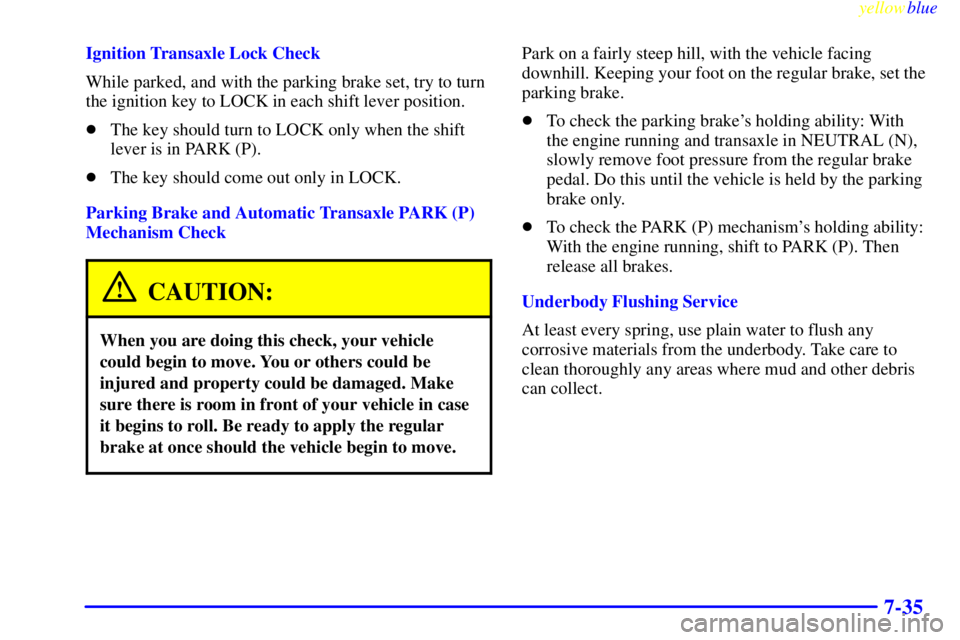
yellowblue
7-35
Ignition Transaxle Lock Check
While parked, and with the parking brake set, try to turn
the ignition key to LOCK in each shift lever position.
�The key should turn to LOCK only when the shift
lever is in PARK (P).
�The key should come out only in LOCK.
Parking Brake and Automatic Transaxle PARK (P)
Mechanism Check
CAUTION:
When you are doing this check, your vehicle
could begin to move. You or others could be
injured and property could be damaged. Make
sure there is room in front of your vehicle in case
it begins to roll. Be ready to apply the regular
brake at once should the vehicle begin to move.
Park on a fairly steep hill, with the vehicle facing
downhill. Keeping your foot on the regular brake, set the
parking brake.
�To check the parking brake's holding ability: With
the engine running and transaxle in NEUTRAL (N),
slowly remove foot pressure from the regular brake
pedal. Do this until the vehicle is held by the parking
brake only.
�To check the PARK (P) mechanism's holding ability:
With the engine running, shift to PARK (P). Then
release all brakes.
Underbody Flushing Service
At least every spring, use plain water to flush any
corrosive materials from the underbody. Take care to
clean thoroughly any areas where mud and other debris
can collect.